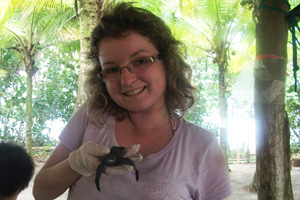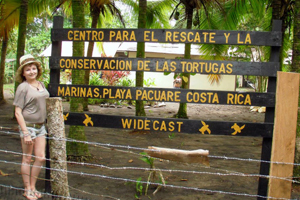
Morning: A typical day working for Widecast in Pacuare would start with waking up at 7-7.30am for breakfast which would be available between 7.30am-10am and consisted of pancakes, scrambled egg, pineapple and/or watermelon and occasionally Galla Pinto (Costa Rican rice and beans dish). We had to wash up our plates after finishing breakfast and then there was time to have showers and get dressed. The mornings were never very busy as many people had night shifts so they were a good time to lounge in the hammocks, write in journals or read books.
Afternoon: In the afternoons we usually had either Hatchery work or beach cleaning. Hatchery work meant digging in the Hatchery (where the turtle nests were being looked after) creating a two meter wide, one meter deep hole and then bleaching the sand, leaving it for three days, and then filling in the hole. This was to stop ay bacteria or plants from trying to grow in the Hatchery, to give the turtle eggs more chance of hatching and the hatchlings more chance of survival. If we were not doing Hatchery work, we were beach cleaning. We would walk along sections of the six mile long beach with rubbish sacks and rakes, putting any litter found in the rubbish sacks and rake debris into the edge of the jungle.
Evening: In the evenings, dinner would be 6-8pm and if you didn’t have a night shift you could just relax and socialise with the people around you. We used to play games of UNO and make friendship bracelets with our ISV group and the other volunteers who were there helping Widecast. Night patrol schedules were at 8pm-12am, 10pm-2am or 12am-4am and you would walk either Sector A, B or C for the whole 4 hours with a team leader and usually one other, so there was 3 of you on a patrol. You would look for turtle tracks on the sand, nests made and also looking for turtles coming out the sea to lay their eggs and protect them from any poachers also walking the beach. You may have had a Hatchery night shift which were rotated every 6 hours so, 6pm-12am, 12am-6am, 6am-12pm, 12pm-6pm. This involved guarding the Hatchery areas and checking the nests every 10 minutes for crabs, flies or any nests hatching.

Highlights: A highlight of my trip happened on the second day on arriving to the Widecast site. We were walking along the beach and our ISV leader Andrey spotted a hole in the sand on the edge of the jungle and a single baby leatherback turtle was moving inside the hole! It was a natural nest and we ended up finding 79 hatchlings in the hole, which we carried back to the Widecast station, weighed and measured fifteen of them and then released them into the sea!
A second highlight occurred on my last night patrol before we left the project. I was lucky enough to see a green turtle camouflage her nest and walk behind her as she made her way back to the sea. She was a meter long by 80cm wide. During the course of my patrol I saw three shooting stars and the whole night is something I will never forget!
Both my highlights taught me a lot about turtles, I was able to witness their strength and power they possess, and what turtles feel like, as I got to hold the baby leatherbacks and stroke the shell of the green turtle. I had the experience of watching the turtles move across the sand and into the water and how majestic and elegant they are.